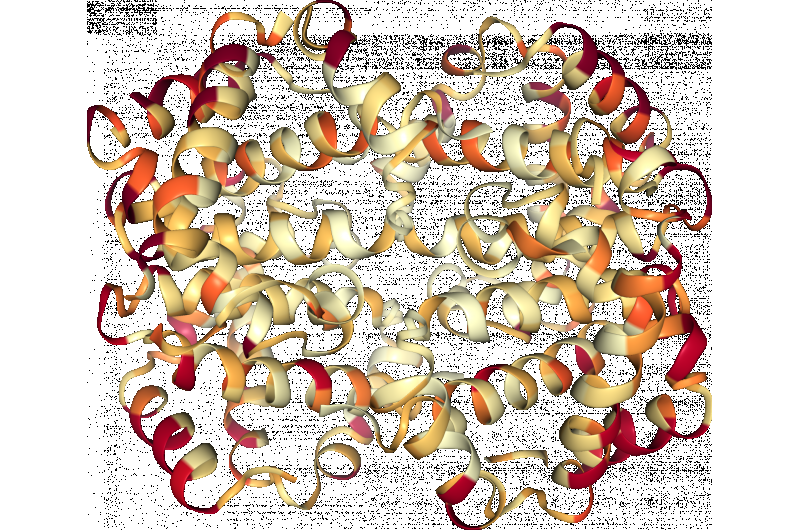A 3-D structure of human haemoglobin, showing residues with high (red) or low (light yellow) evolutionary rates as determined by ModelFinder. Credit: Copyright: Minh Quang Bui/University of Vienna
Understanding evolution is one of the cornerstones of biology—evolution is, in fact, the sole explanation for life's diversity on Earth. Based on the evolution of proteins, researchers may explain the emergence of new species and functions through genetic changes, how enzymes with novel functions might be engineered, or, for example, how humans are related to their closest relatives such as gorillas or bonobos.
One popular approach to the study of evolution is to compare genome data using computer-aided bioinformatics tools. Scientists using these approaches may compare specific proteins, which consist of combinations of 20 universal building blocks called amino acids. The bioinformatics tools used to study the evolution of single proteins have assumed that the speed at which different regions of proteins evolve can be modeled with a statistical distribution whose shape is determined by a single variable.
"That assumption, however, does not reflect reality, and it might have led to a large proportion of biased phylogenetic results being published over the last two decades or so," explains Minh Quang Bui, from the Center for Integrative Bioinformatics (CIBIV) and co-author of the study.
A new algorithm allows insights into protein evolution
Arndt von Haeseler, group leader at the Max F. Perutz Laboratories (MFPL) and Lars Jermiin from the Australian National University have now found a revolutionary way of implementing different rates of evolution into bioinformatics models.
It was well known among experts that the popular approach might not capture the complexities of protein evolution. However, the computational cost of using more realistic models was unacceptably high. "We have now developed a fast algorithm that gives us previously unavailable insights into protein evolution—the new tool is likely to have a huge impact on a wide variety of research areas, including on the evolution of pathogens and the dispersal of agricultural pests," says Jermiin.
The new program, ModelFinder, will allow more accurate scientific estimates of evolutionary processes. This enhanced understanding of evolution will help us come one step closer to unraveling the mysteries, which are responsible for the great diversity on our planet.
More information: Subha Kalyaanamoorthy et al, ModelFinder: fast model selection for accurate phylogenetic estimates, Nature Methods (2017). DOI: 10.1038/NMETH.4285
Journal information: Nature Methods
Provided by University of Vienna























